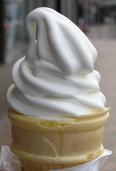
Food Safety Focus (26th Issue, September 2008) – Food Incident Highlight
Coliform and Soft Ice-cream
The Centre for Food Safety (CFS) had recently announced the results of a targeted surveillance on the microbiological quality of ice-cream.
About 1000 ice-cream products were sampled for testing of bacteria level and pathogens during the targeted survey. Different types of ice-creams were collected from both retail and wholesale establishments. No pathogens, including Salmonella spp. and Staphylococcus aureus, were detected in any samples. However, two samples of soft ice-cream were found to contain 570 and 170 coliform organisms per gram respectively, which exceeded the legal standard of less than 100 per gram. Warning letters were issued to the food premises concerned.
Coliforms, which are often used to monitor food quality, are not a single species of organism. They are a group of gram negative rod-shaped bacteria that have similar biochemical characteristics of being able to ferment lactose with the production of acid and gas within 48 hours at 35oC and grow with or without oxygen. They are usually present in small number in raw milk, meat, poultry or other raw foods. Coliforms count is simple and easy to conduct, hence it can be used as an hygienic indicator to reflect the general microbiological quality in routine test. As coliform organisms can easily be killed by heat, these bacteria can also be used as an indicator of heat treatment failure (e.g. inadequate heat treatment during pasteurisation of soft ice-cream mix) as well as post heat treatment contamination (e.g. contamination by food handlers or unclean machines).
Food premises which provide soft ice-cream should ensure that their food are fit for consumption and meet legal requirements. They should observe good hygiene practices when preparing and handling soft ice-cream.
Illustration: Soft ice-cream

